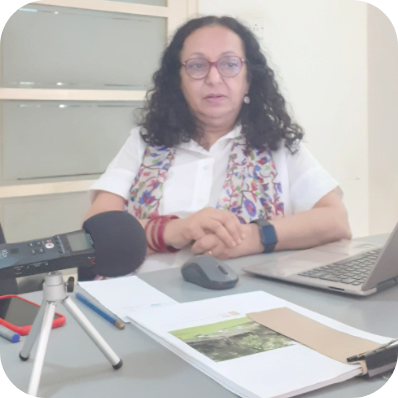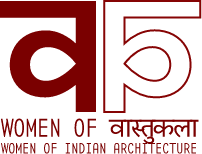
Nina Chandavarkar
Nina Chandavarkar graduated as an architect from the School of Planning and Architecture, New Delhi, and further pursued postgraudate studies at UPenn. She started practicing as an independent landscape architect in 1986 and later formed a partnership by the name of Oikos Landscape Architects, Bangalore, where they engage in landscape projects of various scales. She is personally quite passionate about the ecological restoration of sites and spaces.
INTERVIEWEES
Formative years, landscape architecture and architecture education
Summary:She set up her own practice specializing in landscape architecture on coming back to India in 1989 and describes balancing her roles as a practitioner and new mother. Remarking on the nascent industry of landscape architecture, especially in Bangalore, she talks about the challenges and work processes she took on, bringing up instances from some of her first large-scale projects. She talks about more than a dozen projects her firm completed in Electronic City, Bangalore during the IT boom, including projects for companies like Hewlett Packard, Infosys, Wipro, etc., and similar work in Pune and Hyderabad. She talks about work done on institutional campuses, resorts, parks, and large-scale apartment complexes. On adopting sustainable work practices and technologies since the 1990s, she mentions eco-restoration, groundwater recharge, harvesting, etc. for projects. From the time she spent in Philadelphia, she talks about her experience as an Assistant to a design professor after her graduate studies and further teaching experiences. Further talking about graduate school, she describes her overall impressions of the course. She mentions her classmate Revathi Kamath and describes her strong opinions on the importance of women staying in the workforce, especially since the effects of Covid-19.
Nina Chandavarkar
Nina Chandavarkar
Ishita Shah
00.35.53
Offline
24/11/2021
English
(00:14:24:01) NGO with marginal labour, (00:18:31:24) Trends in landscape architecture, (00:21:21:02) Process for public projects, (00:25:36:07) Second ISOLA Conference on water in Bangalore
Gender in the workspace, setting up practice and notable project
Summary:In responding to a question on the kind of research required in the field currently, she explains the empirical research that is necessary to understand the nurturement of plants in a built environment. Furthermore, she explains the importance of appropriately choosing building materials in a sustainable manner and technologies that can facilitate them. On formalizing landscape architecture through regulations involved in the field, she points out how they can be superfluous. Moreover, she describes the state of the practice of landscape architecture and the recognition it has in India. She believes it is generally seen only as an ‘icing on a cake’ and not integrated with urban design as it should be. She mentions successful masterplans, such as the Indian Institute of Technology (IIT) – Tiruchirappalli, which was created in keeping with factors like the natural resources, lay of the land, etc. Going back to the requirements of by-laws, she talks about navigating through some of the helpful and other not-so-helpful ones with her projects and their implications on cost and integrative design. Concluding on what she understands about Real Estate Regulatory Authority (RERA), she explains its pros and cons in the context of landscape architecture planning.
Nina Chandavarkar
Nina Chandavarkar
Ishita Shah
00.29.07
Offline
24/11/2021
English
(00:00:33:18) Being a woman architect, (00:02:19:20) Choice of clothing as a woman architect, (00:11:49:28) Research and education in landscape architecture, (00:15:32:09) Government intervention in formalising landscape architecture, (00:21:45:27) By-law on OSR in cities pertaining to landscape development, (00:26:15:18) RERA laws for real estate
Work process, gendered experiences and relations with Tara Chandavarkar
Summary:Speaking of architect Tara Chandarvarkar, Nina talks about what she knew about her family and educational background. She describes her prompt journey in taking on an architectural practice after losing her husband quite early, to running the largest architectural firm in India. She explains the different aspects of the firm she worked for and how she built up the firm with the help of many colleagues and family members. Due to her vast and unique contribution to architecture, she mentions how she was felicitated with a citation from the Council of Architects, even though she did not hold an architectural degree.
Nina Chandavarkar
Nina Chandavarkar
Ishita Shah
00.28.17
Offline
24/11/2021
English
(00:05:31:25) Open spaces in cities, (00:08:04:24) Significance of public space, (00:10:14:01) Need to loiter, (00:14:48:26) Empowering working mothers, (00:19:11:13) Challenges of working mothers
Project experience, approach from college and early practice
Summary:When she got back to India in 1986, she began working on smaller projects and described the shift she felt in design aesthetics and detailing. Soon in 1989, she set up her practice in a young industry, and she goes on to explain the challenges she faced including fulfilling basic requirements like securing contractors which were soon overcome within a few years into her practice. In the 1990s, she says how she took on large-scale projects that involved industries and residences, mentioning details of some of those projects. She recalls some of the client negotiations and talks about comparisons between India’s and US’s landscape needs she had to draw from during her work. Furthermore, she talks about the sustainable technologies and processes she adopted in the majority of her projects starting early. Talking about the time she spent in Ram Sharma’s office, she describes the varied scale projects she worked on including a hospital, an agricultural fair, a competition for a sports complex, individual homes, etc. Going back to the education she received at UPenn, she fondly remembers a professor who disrupted her way of thinking which led to a paradigm shift in the way she approached her work.
Nina Chandavarkar
Nina Chandavarkar
Ishita Shah
00.33.10
Offline
12/01/2022
English
(00:03:39:21) Architecture thesis on crafts village in Jaipur, (00:16:37:10) Research process for landscape plans in India, (00:21:02:22) Campus Design for software companies, (00:27:36:07) Approach of landscape design in Ram Sharma's office
Ecology, sustainable practice and collaborations
Summary:She talks about collaborations with eminent architects, including B V Doshi, the Chief Horticulture Officer at Lalbagh, and more. She dwells in conversations about the large natural forest reserves and the local forest dependency culture in Orissa, sharing tales of concerning clients and research stories she could recall. Coming back to Bangalore, she talks about campus landscape projects she worked on and the intricacies involved in developing designs in tandem with ecological needs. Moreover, she moves on to respond to a question on the organic systems within structured landscape designs, especially in a large-scale project. In the context of eco-restoration, she talks about the processes involved in large projects in a way to allow the usability of spaces while she brings up a few examples.
Nina Chandavarkar
Nina Chandavarkar
Ishita Shah
00.26.38
Offline
12/01/2022
English
(00:13:47:12) Campus design in Bangalore, (00:14:52:01) NCBS Mortis Morbius exhibition, (00:18:15:02) Approach to Campus Design
Work and bureaucratic relations
Summary:On her experience with bureaucratic collaborations, she describes the challenges she faced and how she navigated the private-public partnership projects including parks, etc. Furthermore, she dwells on her design intent and research process and how she integrates an ecology’s organic function in her designs for the parks. Moving on, she details the approach she took up when she saw a bottleneck in work relations she shared with different levels of management and architects, especially in the context of gender bias. On working with BBMP and the language constraints she faced while working across the many other states her projects have taken her, she recalls how she mediated the issue while crediting the project manager in the process. In conclusion, she recalls some of the women architects she worked with and those who stood out to her.
Nina Chandavarkar
Nina Chandavarkar
Ishita Shah
00.30.00
Offline
12/01/2022
English
(00:03:14:08) Interactions with different contractors for landscape practice, (00:09:05:12) Collaboration with the government, (00:13:56:22) Landscape approach for public parks, (00:21:04:07) Role of language in procuring government projects
Notable projects and clients
Summary:Moving on to talk about one of the first projects that were handed to the firm in 1992, she recalls the preservation efforts and work process that went behind the sites and services project at the edge of a mangrove forest in Maharashtra. On the industrial projects she soon took on, she talks about the challenging work that needed to go into a specific site of about 192 acres, as well as the exacting client negotiations. She recalls the various design elements and strategies she used for the huge landscapes involved, and to stimulate healthy competition on the project team. On the 5-acre Infosys project she designed, she remembers the space she had to work with and recreate. Speaking further on the design elements she implemented on a second expanded software campus, she remembers the resources and client relations she had to navigate and her overall fulfilling experience working on it. Moving on, she talks about the team that worked behind the Infosys projects, and other projects that come to her mind, including the 120-acre Indian Institute of Management (IIM) – Tiruchirappalli and the 20-acre Mindtree Kalinga. The IIM project was one that the CNT Architects won in a competition and she remembers the design concept, materials, and spaces that went behind the project.
Nina Chandavarkar
Nina Chandavarkar
Ishita Shah
00.30.01
Offline
25/04/2022
English
(00:06:37:01) Teaching primary kids about plants, (00:07:19:14) Significance of the name Oikos, (00:11:43:29) MHADA housing after development
Eco-restoration and conservation efforts, clients and aspirations
Summary:Nina Chandavarkar
Nina Chandavarkar
Ishita Shah
00.34.41
Offline
25/04/2022
English
(00:00:43:22) Residential landscape projects, (00:05:55:01) Scale of site and landscape architecture, (00:09:46:02) Contextualised landscape design, (00:15:17:11) Water Bodies in landscape design, (00:20:23:22) Flexibility of plants in residential landscape design, (00:24:47:05) Journey of Oikos, (00:27:05:00) Convincing clients
